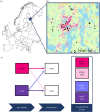Effects of past and present habitat on the gut microbiota of a wild rodent
- PMID: 38320610
- PMCID: PMC10846943
- DOI: 10.1098/rspb.2023.2531
Effects of past and present habitat on the gut microbiota of a wild rodent
Abstract
The response of the gut microbiota to changes in the host environment can be influenced by both the host's past and present habitats. To quantify their contributions for two different life stages, we studied the gut microbiota of wild bank voles (Clethrionomys glareolus) by performing a reciprocal transfer experiment with adults and their newborn offspring between urban and rural forests in a boreal ecosystem. Here, we show that the post-transfer gut microbiota in adults did not shift to resemble the post-transfer gut microbiota of animals 'native' to the present habitat. Instead, their gut microbiota appear to be structured by both their past and present habitat, with some features of the adult gut microbiota still determined by the past living environment (e.g. alpha diversity, compositional turnover). By contrast, we did not find evidence of the maternal past habitat (maternal effects) affecting the post-transfer gut microbiota of the juvenile offspring, and only a weak effect of the present habitat. Our results show that both the contemporary living environment and the past environment of the host organism can structure the gut microbiota communities, especially in adult individuals. These data are relevant for decision-making in the field of conservation and wildlife translocations.
Keywords: flexibility; gut microbiota; reciprocal transfer experiment; resistance; translocation; urban.
Conflict of interest statement
The authors declare no competing interests.
Figures



Similar articles
-
Idiosyncratic effects of coinfection on the association between systemic pathogens and the gut microbiota of a wild rodent, the bank vole Myodes glareolus.J Anim Ecol. 2023 Apr;92(4):826-837. doi: 10.1111/1365-2656.13869. Epub 2022 Dec 18. J Anim Ecol. 2023. PMID: 36504351
-
Low-level environmental metal pollution is associated with altered gut microbiota of a wild rodent, the bank vole (Myodes glareolus).Sci Total Environ. 2021 Oct 10;790:148224. doi: 10.1016/j.scitotenv.2021.148224. Epub 2021 Jun 2. Sci Total Environ. 2021. PMID: 34380250
-
Skin and gut microbiomes of a wild mammal respond to different environmental cues.Microbiome. 2018 Nov 26;6(1):209. doi: 10.1186/s40168-018-0595-0. Microbiome. 2018. PMID: 30477569 Free PMC article.
-
The Human Gut Microbiota: A Dynamic Biologic Factory.Adv Biochem Eng Biotechnol. 2025;189:91-106. doi: 10.1007/10_2023_243. Adv Biochem Eng Biotechnol. 2025. PMID: 38337077 Review.
-
The gut microbiota of wild rodents: Challenges and opportunities.Lab Anim. 2019 Jun;53(3):252-258. doi: 10.1177/0023677218787538. Epub 2018 Jul 20. Lab Anim. 2019. PMID: 30027821 Review.
References
MeSH terms
LinkOut - more resources
Full Text Sources
Miscellaneous

